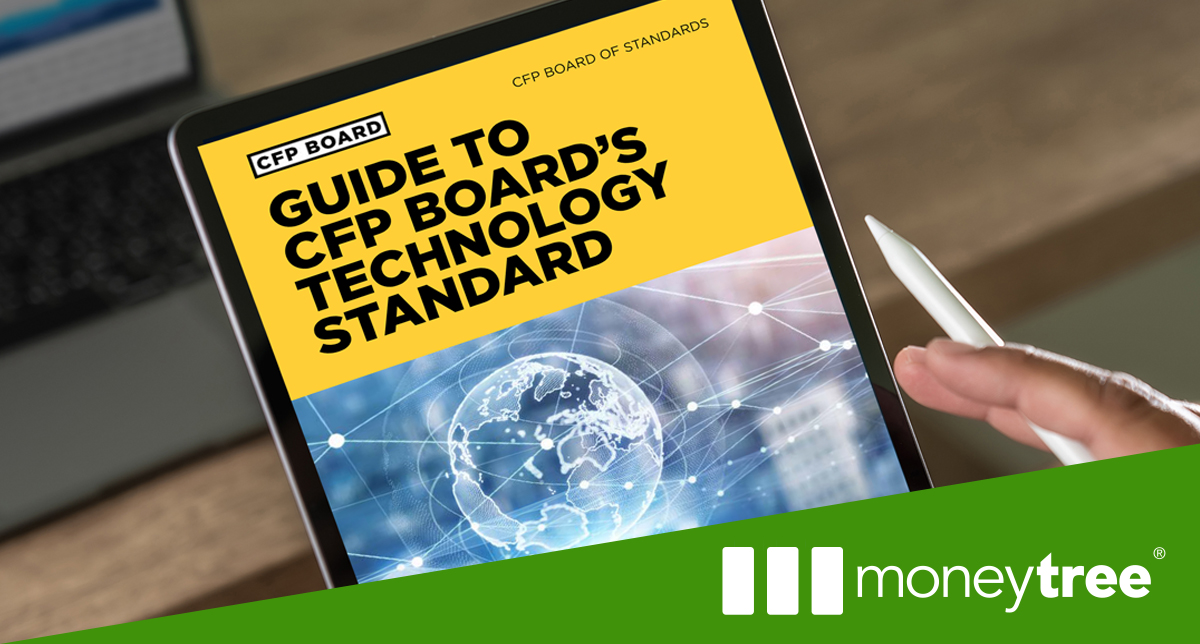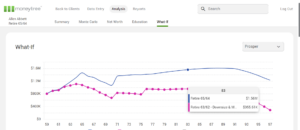If you’re a Certified Financial Planner, you have proven that you have what it takes to help clients achieve their financial goals.
You’re principled. You’re experienced. You’re intelligent. You’re accountable.
But what about the software you use to apply your knowledge and expertise to real-world situations? Does your technology meet professional standards, too? And what are those professional standards?
These are the questions that the CFP board asked itself recently, resulting in a first-of-its-kind Tech Guide from the organization, released in February 2024.
“We appreciate the clarity this guide brings to navigating the complexities of technological integration in financial planning,” said Patrick Spencer, Managing Director, Moneytree Software. “The ability for financial planners to adapt swiftly to changing technology is crucial.”
Having been in the financial planning software business for over 40 years, Moneytree has a lot to say on this topic.
And it’s no wonder that the CFP board asked Spencer to join a group of volunteers to help steer the conversation and draft the guide.
Who can you trust?
Now more than ever, the financial planning world needs clarification on how to select, use, and recommend technology for client service.
The reason is that the financial technology marketplace has become crowded. Financial planners have so many options now that buying technology can be an overwhelming and confusing experience.
New tech companies seem to be popping up every day, and many of them are narrowly focused, offering a specialized tool that tackles just one problem. Further complicating matters is that many of these companies are backed by private-equity investors looking to get in, make a buck, and then sell off.
“If you’re not careful, you end up buying expensive, redundant systems with overlapping functions,” Spencer said. “And when you rely on multiple systems, you end up with data silos, potential security risks, and inefficient operations.”
This problem is called tech bloat.
So, who can you trust?
The four primary considerations
The guide presents key considerations for meeting the CFP Board’s Technology Standard, with a primary focus on:
- Reasonably understanding the technology platform and how each component is used to provide professional services.
- Monitoring and assessing the technology platform for any issues or gaps that would prevent the CFP professional from acting in the client’s best interests.
- Knowing which assumptions are embedded in the technology and whether those assumptions are appropriate.
- Reviewing the reliability, accuracy, and objectivity of the technology’s outcomes against the client’s information and underlying assumptions.
Reasonably understand the technology
This key consideration is all about knowing a software’s functions, features, capabilities, and potential risks.
Moneytree Product Manager Matt Garrett said too many consumers don’t do enough research, often buying the most popular software or following the advice of others. Instead, dig into how you would apply the software to your own business and how you work, Garrett said.
Simply put, it’s a matter of due diligence.
“Don’t follow the path of least resistance,” Garrett said. “This is about making a judgment call based on the things that you want to do with your practice and what fits you best.”
Jason Hessler, a Certified Financial Planner and attorney agreed. Hessler is owner of Full Suite Wealth in Indiana.
“The functionality has to be specific to my practice,” he said. “How can I incorporate it into what I do? I need something that allows me to manage complex portfolios.”
One of the best ways to comply with this consideration is to take advantage of free trials before you make a purchase, according to Spencer.
“Furthermore,” Spencer said. “A free trial should have access to support, so that you have a full understanding of what your relationship with that provider will be like.”
Monitor and assess the technology
This key consideration involves both how you use your existing technology and how you select new technology.
For technology you already own, you must stay on top of updates and security patches. Technology is always evolving, and making sure you have the latest version helps you deliver the best service to your clients.
CFP firms, the guide says, should have processes in place for this.
If you’re in the process of buying software, the CFP board suggests you be mindful of how it will fit into your tech stack and whether it will help facilitate advice that’s in your clients’ best interest.
“The heart of this recommendation is this: Is the tool that is right for you also the tool that is right for your client,” Garrett said.
Spencer agreed.
“It’s not only about the advisor’s experience,” Spencer said. “There has to be a marriage between their technology and the end client.”
According to Hessler, choosing software with client-centric reports can be a real differentiator, especially for independent firms.
“I’m an educator at heart,” he said. “I need something that catches the clients’ attention. And I need resources I can put it in front of a client that makes it all easy to understand.”
Know the assumptions
According to the tech guide: “A CFP® professional must know what assumptions the technology utilizes, the basis for these assumptions, and whether they are appropriate.”
Common assumptions that arise with financial planning software include:
- Inflation rates
- Tax calculations
- Health care expenses
- Social Security benefits.
These assumptions are all subject to change, so planning software providers must be providing timely and dependable updates.
If they aren’t it might be time to look for another provider.
“Every year there are changes that need to happen within the software due to regulations, economics, and other events,” Garrett said. “If companies aren’t keeping up with it, you could have a period of time when your plans are inaccurate.”
Review reliability, accuracy, and objectivity
A CFP should never blindly trust automated calculations within software.
Instead, they should use their own professional skill and judgment to assess whether the technology’s outputs are:
- Accurate and error-free.
- The product of bias or conflicts of interest.
- Proper for the client’s circumstances.
But one of the biggest problems in financial planning software right now, according to Spencer, is that many leading platforms are not transparent and don’t allow users to evaluate automated calculations.
“Are your tools calculating from inside a black box?” he said. “If you are running a report, can you be certain the numbers are true? Can you see the work and cross reference the calculations. If you can’t, then is that the right tool for your client?”
Another consideration, according to Spencer, is disaster recovery.
Today’s fintech SaaS firms cannot afford to just have one production environment to run their application. Prudent software development requires firms to have a second environment for disaster recovery, that could be stood up, or operational, within an acceptable time period, typically 24-48 hours.
Not having this second environment puts the advisor and their clients at risk.
“If something happens in the cloud, can they keep you safe and operational?” Spencer said. “You need to ask the right questions of these vendors.”
Some advice for new advisors
There are a lot of new advisors in the market right now, a mix of both young advisors starting their career and not-so-young advisors starting a second career.
Buying software can feel overwhelming, especially for new advisors, Spencer said.
The guide is a great resource, and there’s plenty more to it than we’ve explained in this summary.
“Work through these objectives and check out the sample questions in the technology guide,” Spencer concluded. “This is how you can use software to marry your needs with your clients’ needs.”




